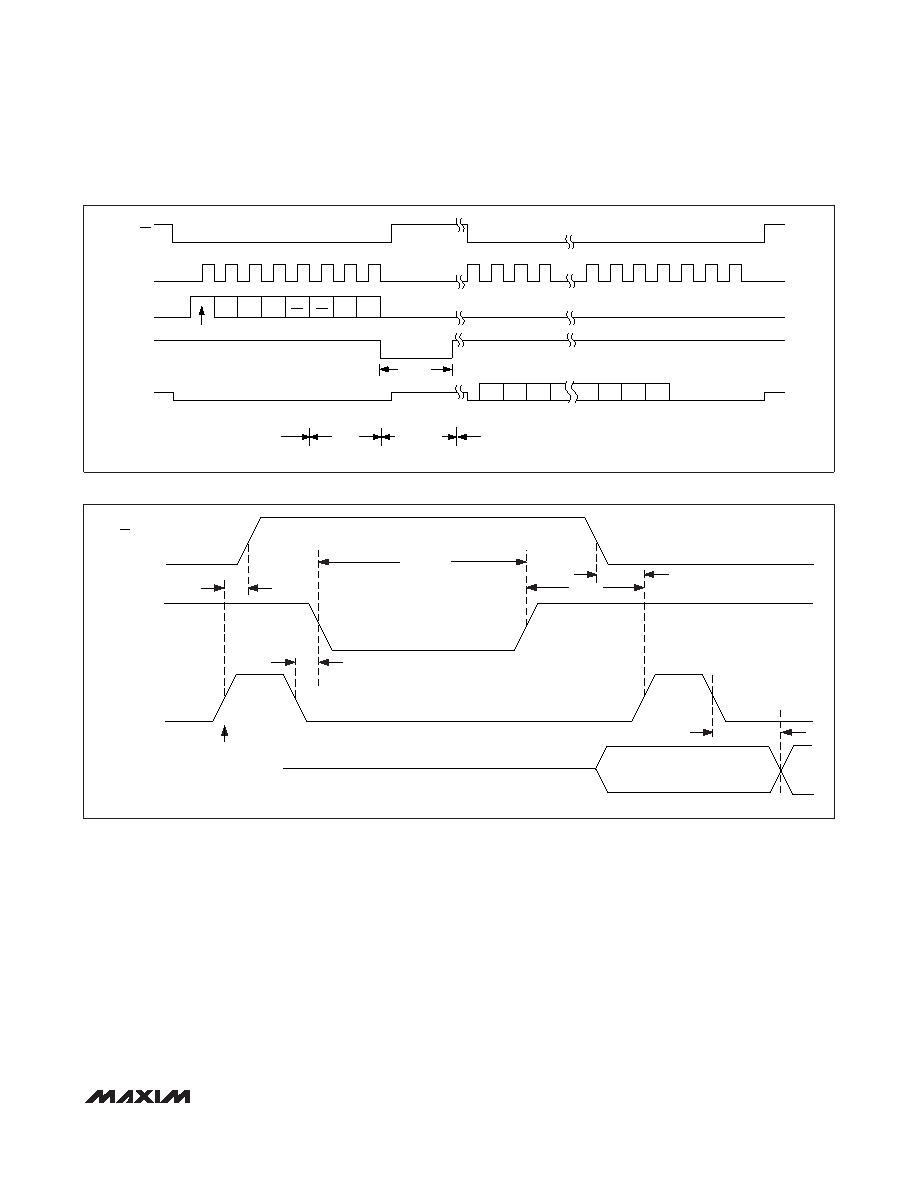- 您现在的位置:买卖IC网 > Sheet目录2008 > MAX1245BCPP (Maxim Integrated Products)IC ADC SRL 12BIT 2.375V 20-DIP

selected, SSTRB does not go into a high-impedance
state when CS goes high.
Figure 10 shows the SSTRB timing in internal clock
mode. In this mode, data can be shifted in and out of
the MAX1245 at clock rates exceeding 1.5MHz, provid-
ed that the minimum acquisition time, tACQ, is kept
above 2.0s.
Data Framing
The falling edge of CS does not start a conversion on
the MAX1245. The first logic high clocked into DIN is
interpreted as a start bit and defines the first bit of the
control byte. A conversion starts on the falling edge of
SCLK, after the eighth bit of the control byte (the PD0
bit) is clocked into DIN. The start bit is defined as:
The first high bit clocked into DIN with CS low any
time the converter is idle; e.g., after VDD is applied.
OR
The first high bit clocked into DIN after bit 5 of a con-
version in progress is clocked onto the DOUT pin.
If CS is toggled before the current conversion is com-
plete, then the next high bit clocked into DIN is recog-
nized as a start bit; the current conversion is terminated,
and a new one is started.
MAX1245
+2.375V, Low-Power, 8-Channel,
Serial 12-Bit ADC
______________________________________________________________________________________
13
SSTRB
CS
SCLK
DIN
DOUT
14
8
12
18
20
24
START
SEL2 SEL1 SEL0
UNI/
BIP
SGL/
DIF
PD1
PD0
B11
MSB
B10
B9
B2
B1
B0
LSB
FILLED WITH
ZEROS
IDLE
CONVERSION
7.5
s MAX
(SHDN = OPEN)
2
3
5
6
7
9
10
11
19
21
22
23
tCONV
ACQUISITION
(SCLK = 1.5MHz)
IDLE
A/D STATE
2.0
s
PD0 CLOCK IN
tSSTRB
tCSH
tCONV
tSCK
SSTRB
SCLK
DOUT
tCSS
tDO
NOTE: FOR BEST NOISE PERFORMANCE, KEEP SCLK LOW DURING CONVERSION.
CS
Figure 9. Internal Clock Mode Timing
Figure 10. Internal Clock Mode SSTRB Detailed Timing
发布紧急采购,3分钟左右您将得到回复。
相关PDF资料
MAX1249AEPE+
IC ADC 10BIT SERIAL 16-DIP
MAX1279AETC+
IC ADC 12BIT 1.5MSPS 12-TQFN
MAX1285BESA+T
IC ADC 12BIT 300KSPS 8-SOIC
MAX1302BEUG+
IC ADC 16BIT SRL 115KSPS 24TSSOP
MAX1303BEUP+
IC ADC 16BIT MULT RANGE 20TSSOP
MAX1308ECM+T
IC ADC 12BIT 8CH 4MSPS 48LQFP
MAX1320ECM+T
IC ADC 14BIT 8CH 2MSPS 48LQFP
MAX132EWG+T
IC ADC 18BIT SERIAL 24-SOIC
相关代理商/技术参数
MAX1245BCPP+
功能描述:模数转换器 - ADC 10-Bit 8Ch 100ksps 3.3V Precision ADC RoHS:否 制造商:Texas Instruments 通道数量:2 结构:Sigma-Delta 转换速率:125 SPs to 8 KSPs 分辨率:24 bit 输入类型:Differential 信噪比:107 dB 接口类型:SPI 工作电源电压:1.7 V to 3.6 V, 2.7 V to 5.25 V 最大工作温度:+ 85 C 安装风格:SMD/SMT 封装 / 箱体:VQFN-32
MAX1245BEAP
功能描述:模数转换器 - ADC Integrated Circuits (ICs) RoHS:否 制造商:Texas Instruments 通道数量:2 结构:Sigma-Delta 转换速率:125 SPs to 8 KSPs 分辨率:24 bit 输入类型:Differential 信噪比:107 dB 接口类型:SPI 工作电源电压:1.7 V to 3.6 V, 2.7 V to 5.25 V 最大工作温度:+ 85 C 安装风格:SMD/SMT 封装 / 箱体:VQFN-32
MAX1245BEAP+
功能描述:模数转换器 - ADC 10-Bit 8Ch 100ksps 3.3V Precision ADC RoHS:否 制造商:Texas Instruments 通道数量:2 结构:Sigma-Delta 转换速率:125 SPs to 8 KSPs 分辨率:24 bit 输入类型:Differential 信噪比:107 dB 接口类型:SPI 工作电源电压:1.7 V to 3.6 V, 2.7 V to 5.25 V 最大工作温度:+ 85 C 安装风格:SMD/SMT 封装 / 箱体:VQFN-32
MAX1245BEAP+T
功能描述:模数转换器 - ADC 10-Bit 8Ch 100ksps 3.3V Precision ADC RoHS:否 制造商:Texas Instruments 通道数量:2 结构:Sigma-Delta 转换速率:125 SPs to 8 KSPs 分辨率:24 bit 输入类型:Differential 信噪比:107 dB 接口类型:SPI 工作电源电压:1.7 V to 3.6 V, 2.7 V to 5.25 V 最大工作温度:+ 85 C 安装风格:SMD/SMT 封装 / 箱体:VQFN-32
MAX1245BEAP-T
功能描述:模数转换器 - ADC RoHS:否 制造商:Texas Instruments 通道数量:2 结构:Sigma-Delta 转换速率:125 SPs to 8 KSPs 分辨率:24 bit 输入类型:Differential 信噪比:107 dB 接口类型:SPI 工作电源电压:1.7 V to 3.6 V, 2.7 V to 5.25 V 最大工作温度:+ 85 C 安装风格:SMD/SMT 封装 / 箱体:VQFN-32
MAX1245BEPP
功能描述:模数转换器 - ADC RoHS:否 制造商:Texas Instruments 通道数量:2 结构:Sigma-Delta 转换速率:125 SPs to 8 KSPs 分辨率:24 bit 输入类型:Differential 信噪比:107 dB 接口类型:SPI 工作电源电压:1.7 V to 3.6 V, 2.7 V to 5.25 V 最大工作温度:+ 85 C 安装风格:SMD/SMT 封装 / 箱体:VQFN-32
MAX1245BEPP+
功能描述:模数转换器 - ADC 10-Bit 8Ch 100ksps 3.3V Precision ADC RoHS:否 制造商:Texas Instruments 通道数量:2 结构:Sigma-Delta 转换速率:125 SPs to 8 KSPs 分辨率:24 bit 输入类型:Differential 信噪比:107 dB 接口类型:SPI 工作电源电压:1.7 V to 3.6 V, 2.7 V to 5.25 V 最大工作温度:+ 85 C 安装风格:SMD/SMT 封装 / 箱体:VQFN-32
MAX1245BMJP
功能描述:模数转换器 - ADC RoHS:否 制造商:Texas Instruments 通道数量:2 结构:Sigma-Delta 转换速率:125 SPs to 8 KSPs 分辨率:24 bit 输入类型:Differential 信噪比:107 dB 接口类型:SPI 工作电源电压:1.7 V to 3.6 V, 2.7 V to 5.25 V 最大工作温度:+ 85 C 安装风格:SMD/SMT 封装 / 箱体:VQFN-32